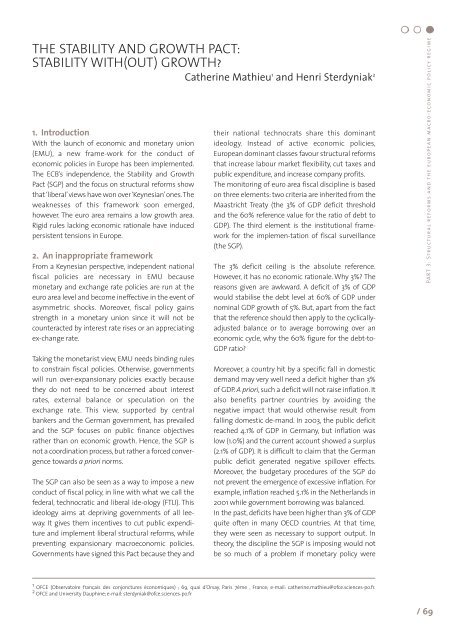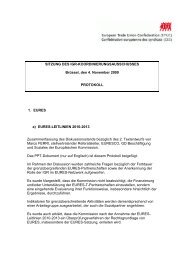Structural reforms and macro-economic policy - ETUC
Structural reforms and macro-economic policy - ETUC
Structural reforms and macro-economic policy - ETUC
You also want an ePaper? Increase the reach of your titles
YUMPU automatically turns print PDFs into web optimized ePapers that Google loves.
THE STABILITY AND GROWTH PACT:<br />
STABILITY WITH(OUT) GROWTH?<br />
Catherine Mathieu 1 <strong>and</strong> Henri Sterdyniak 2<br />
1. Introduction<br />
With the launch of <strong>economic</strong> <strong>and</strong> monetary union<br />
(EMU), a new frame-work for the conduct of<br />
<strong>economic</strong> policies in Europe has been implemented.<br />
The ECB’s independence, the Stability <strong>and</strong> Growth<br />
Pact (SGP) <strong>and</strong> the focus on structural <strong>reforms</strong> show<br />
that ‘liberal’views have won over ‘Keynesian’ones.The<br />
weaknesses of this framework soon emerged,<br />
however. The euro area remains a low growth area.<br />
Rigid rules lacking <strong>economic</strong> rationale have induced<br />
persistent tensions in Europe.<br />
2. An inappropriate framework<br />
From a Keynesian perspective, independent national<br />
fiscal policies are necessary in EMU because<br />
monetary <strong>and</strong> exchange rate policies are run at the<br />
euro area level <strong>and</strong> become ineffective in the event of<br />
asymmetric shocks. Moreover, fiscal <strong>policy</strong> gains<br />
strength in a monetary union since it will not be<br />
counteracted by interest rate rises or an appreciating<br />
ex-change rate.<br />
Taking the monetarist view, EMU needs binding rules<br />
to constrain fiscal policies. Otherwise, governments<br />
will run over-expansionary policies exactly because<br />
they do not need to be concerned about interest<br />
rates, external balance or speculation on the<br />
exchange rate. This view, supported by central<br />
bankers <strong>and</strong> the German government, has prevailed<br />
<strong>and</strong> the SGP focuses on public finance objectives<br />
rather than on <strong>economic</strong> growth. Hence, the SGP is<br />
not a coordination process, but rather a forced convergence<br />
towards a priori norms.<br />
The SGP can also be seen as a way to impose a new<br />
conduct of fiscal <strong>policy</strong>, in line with what we call the<br />
federal, technocratic <strong>and</strong> liberal ide-ology (FTLI). This<br />
ideology aims at depriving governments of all leeway.<br />
It gives them incentives to cut public expenditure<br />
<strong>and</strong> implement liberal structural <strong>reforms</strong>, while<br />
preventing expansionary <strong>macro</strong><strong>economic</strong> policies.<br />
Governments have signed this Pact because they <strong>and</strong><br />
their national technocrats share this dominant<br />
ideology. Instead of active <strong>economic</strong> policies,<br />
European dominant classes favour structural <strong>reforms</strong><br />
that increase labour market flexibility, cut taxes <strong>and</strong><br />
public expenditure, <strong>and</strong> increase company profits.<br />
The monitoring of euro area fiscal discipline is based<br />
on three elements: two criteria are inherited from the<br />
Maastricht Treaty (the 3% of GDP deficit threshold<br />
<strong>and</strong> the 60% reference value for the ratio of debt to<br />
GDP). The third element is the institutional framework<br />
for the implemen-tation of fiscal surveillance<br />
(the SGP).<br />
The 3% deficit ceiling is the absolute reference.<br />
However, it has no <strong>economic</strong> rationale. Why 3%? The<br />
reasons given are awkward. A deficit of 3% of GDP<br />
would stabilise the debt level at 60% of GDP under<br />
nominal GDP growth of 5%. But, apart from the fact<br />
that the reference should then apply to the cyclicallyadjusted<br />
balance or to average borrowing over an<br />
<strong>economic</strong> cycle, why the 60% figure for the debt-to-<br />
GDP ratio?<br />
Moreover, a country hit by a specific fall in domestic<br />
dem<strong>and</strong> may very well need a deficit higher than 3%<br />
of GDP. A priori, such a deficit will not raise inflation. It<br />
also benefits partner countries by avoiding the<br />
negative impact that would otherwise result from<br />
falling domestic de-m<strong>and</strong>. In 2003, the public deficit<br />
reached 4.1% of GDP in Germany, but inflation was<br />
low (1.0%) <strong>and</strong> the current account showed a surplus<br />
(2.1% of GDP). It is difficult to claim that the German<br />
public deficit generated negative spillover effects.<br />
Moreover, the budgetary procedures of the SGP do<br />
not prevent the emergence of excessive inflation. For<br />
example, inflation reached 5.1% in the Netherl<strong>and</strong>s in<br />
2001 while government borrowing was balanced.<br />
In the past, deficits have been higher than 3% of GDP<br />
quite often in many OECD countries. At that time,<br />
they were seen as necessary to support output. In<br />
theory, the discipline the SGP is imposing would not<br />
be so much of a problem if monetary <strong>policy</strong> were<br />
1 OFCE (Observatoire français des conjonctures économiques) ; 69, quai d’Orsay, Paris 7ème , France; e-mail: catherine.mathieu@ofce.sciences-po.fr.<br />
2 OFCE <strong>and</strong> University Dauphine; e-mail: sterdyniak@ofce.sciences-po.fr<br />
PART 3: <strong>Structural</strong> <strong>reforms</strong> <strong>and</strong> the european <strong>macro</strong>-<strong>economic</strong> <strong>policy</strong> regime<br />
/ 69

















